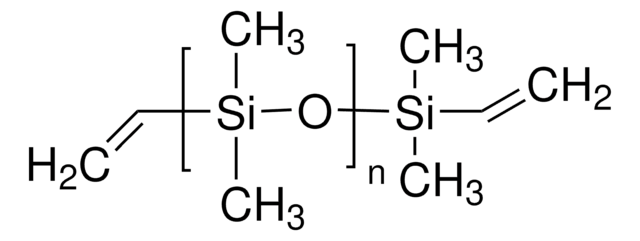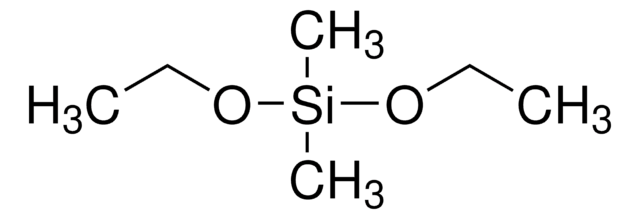63796
(3-Mercaptopropyl)methyldimethoxysilane
≥95.0%
Synonym(s):
Dimethoxy-(3-mercaptopropyl)methylsilane
Sign Into View Organizational & Contract Pricing
All Photos(1)
About This Item
Linear Formula:
CH3Si(OCH3)2CH2CH2CH2SH
CAS Number:
Molecular Weight:
180.34
Beilstein:
2424867
EC Number:
MDL number:
UNSPSC Code:
12352103
PubChem Substance ID:
NACRES:
NA.22
Recommended Products
Quality Level
Assay
≥95.0%
form
liquid
refractive index
n20/D 1.45 (lit.)
n20/D 1.450
bp
96 °C/30 mmHg (lit.)
density
1 g/mL at 25 °C (lit.)
SMILES string
CO[Si](C)(CCCS)OC
InChI
1S/C6H16O2SSi/c1-7-10(3,8-2)6-4-5-9/h9H,4-6H2,1-3H3
InChI key
IKYAJDOSWUATPI-UHFFFAOYSA-N
Looking for similar products? Visit Product Comparison Guide
Application
(3-Mercaptopropyl)methyldimethoxysilane (MPMDMS) can be used as a silane precursor in the synthesis of:
- Nafion-MPMDMS nanocomposite membranes by sol-gel method.
- MPMDMS functionalized magnetic- polysilsesquioxane (PSSQ) nanoparticles applicable for heavy metal ions adsorption.
- Thiol-organosilica nanoparticles.
Signal Word
Warning
Hazard Statements
Precautionary Statements
Hazard Classifications
Eye Irrit. 2 - Skin Irrit. 2 - STOT SE 3
Target Organs
Respiratory system
Storage Class Code
10 - Combustible liquids
WGK
WGK 3
Flash Point(F)
199.4 °F - closed cup
Flash Point(C)
93 °C - closed cup
Personal Protective Equipment
dust mask type N95 (US), Eyeshields, Gloves
Choose from one of the most recent versions:
Already Own This Product?
Find documentation for the products that you have recently purchased in the Document Library.
Customers Also Viewed
One-pot synthesis of multi-functional magnetite- polysilsesquioxane hybrid nanoparticles for the selective Fe3+ and some heavy metal ions adsorption.
Nagappan S, et al.
Royal Society of Chemistry Advances, 7(31), 19106-19116 (2017)
Nafion-MPMDMS nanocomposite membranes with low methanol permeability.
Ladewig BP, et al.
Electrochemical Communications, 9(4), 781-786 (2007)
One-pot synthesis and characterization of three kinds of thiol- organosilica nanoparticles.
Nakamura M and Ishimura K
Langmuir, 24(9), 5099- 5108 (2008)
Pamela J Walsh et al.
Scientific reports, 7(1), 14138-14138 (2017-10-28)
Porous silica is an attractive biomaterial in many applications, including drug-delivery systems, bone-graft fillers and medical devices. The issue with porous silica biomaterials is the rate at which they resorb and the significant role played by interfacial chemistry on the
Chiara Ivaldi et al.
Molecules (Basel, Switzerland), 24(5) (2019-03-03)
The organic⁻inorganic hybrid materials have attracted great attention due to their improved or unusual properties that open promising applications in different areas such as optics, electronics, energy, environment, biology, medicine and heterogeneous catalysis. Different types of silicodactyl platforms grafted on
Our team of scientists has experience in all areas of research including Life Science, Material Science, Chemical Synthesis, Chromatography, Analytical and many others.
Contact Technical Service











![Trimethoxy[3-(methylamino)propyl]silane 95%](/deepweb/assets/sigmaaldrich/product/structures/236/724/a4aa90e7-bf25-425f-9e44-cbc87ffac9fd/640/a4aa90e7-bf25-425f-9e44-cbc87ffac9fd.png)
